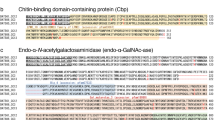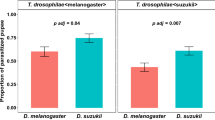Abstract
DEVIATIONS from the normal course of metamorphosis in insects may be caused by parasitic infections1,2. In studies on a microsporidian of the genus Nosema, found in Hyalophora (Platysamia) cecropia and afterwards sub-cultured in Antheraea polyphemus and A. pernyi 3, seventeen of the many infected animals failed to metamorphose normally. The most severely affected were adults of H. cecropia. They retained a number of pupal structures. The tip of the abdomen and the genitalia were pupal in form.; the cuticle of the rest of the abdomen and of the thorax was a mosaic of pupal and adult types and at the base of each eye was an unpigmented band. Such abnormalities can be produced experimentally by introducing active corpora allata or juvenile hormone (neotenin) into the developing adult during the period when its own corpora allata are inactive4,5. Lesser effects were seen in two A. pernyi pupæ that had been formed from infected larvæ. Each had white, larval-type setæ scattered over the abdomen, and crotchets in the position of the larval prolegs. Finally, there were adults of both species of Antheraea which had patches of pupal type cuticle.
This is a preview of subscription content, access via your institution
Access options
Subscribe to this journal
Receive 51 print issues and online access
$199.00 per year
only $3.90 per issue
Buy this article
- Purchase on Springer Link
- Instant access to full article PDF
Prices may be subject to local taxes which are calculated during checkout
Similar content being viewed by others
References
Strickland, E. H., Biol. Bull., 21, 302 (1911).
Halcrow, J. G., Entomol., 87, 122 (1954).
Walters, V. Ann (to be published).
Williams, C. M., The Harvey Lectures, Series 47, 126 (Academic Press, New York, 1952).
Williams, C. M., Nature, 178, 212 (1956).
Piepho, H., Biol. Zbl., 69, 261 (1950).
Wigglesworth, V. B., Quart. J. Micro. Sci., 79, 91 (1936).
Author information
Authors and Affiliations
Rights and permissions
About this article
Cite this article
FINLAYSON, L., WALTERS, V. Abnormal Metamorphosis in Saturniid Moths infected by a Microsporidian. Nature 180, 713–714 (1957). https://doi.org/10.1038/180713b0
Issue Date:
DOI: https://doi.org/10.1038/180713b0
This article is cited by
Comments
By submitting a comment you agree to abide by our Terms and Community Guidelines. If you find something abusive or that does not comply with our terms or guidelines please flag it as inappropriate.



